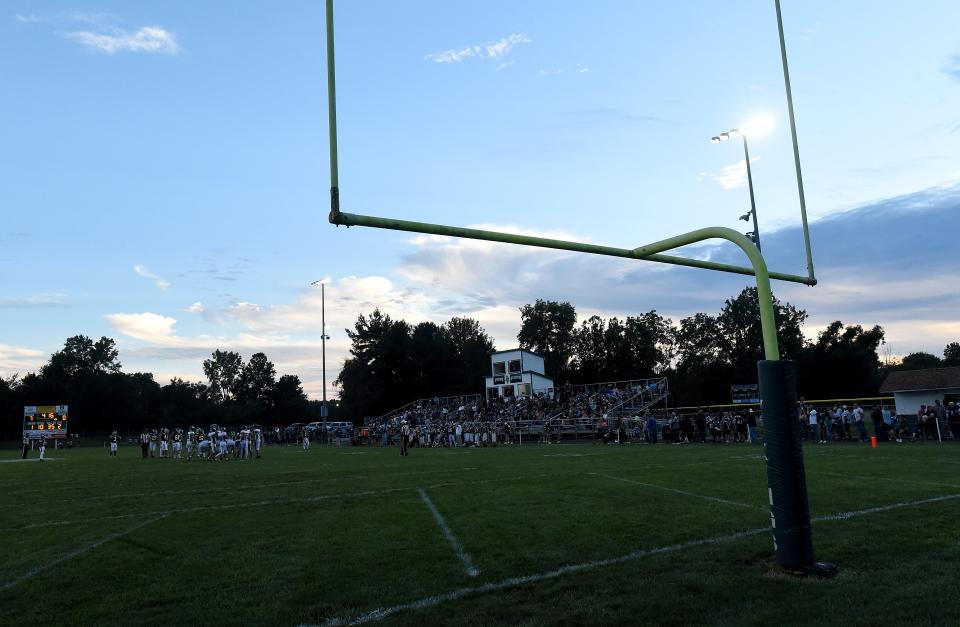Northridge laser focused on stadium upgrade
ALEXANDRIA — It has taken longer than expected, but "Dreams Come Alive" is showing signs of life for a major upgrade to Northridge's Viking Stadium.

The Board of Education's recently-established Ad-Hoc Athletic Master Plan Committee voted 10-0 last week to have Robertson Construction do a feasibility study on what it would cost to upgrade the current stadium, as opposed to building a new facility behind the high school on the east side of the property (current track location). The upgrade could include a new turf field, bleachers, track and restrooms.
The Ad-Hoc Committee includes chairman Jayma Bammerlin, who is also school board vice president, board member Kate Creager, superintendent Scott Schmidt, district treasurer Britt Lewis, athletic boosters president Curt Booher, finance committee member Dave Lees, facilities committee member Nick Miller, owners representative Mike Mendenhall, athletic director Kevin Jarrett and capital improvements chairman Brian Elder. Clay Keith, project executive for Robertson Construction, also attended the meeting. Robertson has signed a contract which will be voted on at the Aug. 15 school board meeting.
The pandemic, the rising cost of construction and labor, supply chain issues and inflation have significantly impacted the timeline and initial budget quotes for the project. "Clay, Mike, Britt, Scott and myself discussed what it would cost to move the facility," Bammerlin said. "It came out to $6.26 million, which is far more than the $4 million goal we had set originally." That includes $2 million from private donations, and $2 million from the district's permanent improvement fund.
To date, $1.6 million in donations has been pledged and $1.4 in cash has been collected, Schmidt said. "We have over 300 donors at different levels, at least half who are voting members of the district," Elder said.
Time is of the essence due to continued rising costs, Keith said. "Every year, you can add in an extra $500,000 due to inflation," he said.
Keith said once a design master plan is finalized, the process takes four to five months, followed by about nine months for actual construction.
"I think we need to be more aggressive, and expedite it as much as we can," Booher said. "In-kind donors are backing out because of the time frame already involved."
"Our first goal is, we need to understand the contract and be able to recommend it to the board at the Aug. 15 meeting, as a capital improvement project," Schmidt said. "The next step is establishing a timeline and identifying options from the master plan." If approved, the design process could be completed by January.
Original plans, formulated in 2019 and announced in the fall of 2021 by Northridge's athletic and band boosters, called for new turf, a track, bleachers and a multi-purpose building, to be built on the site of the current stadium in time for the 2022 fall sports season. When that timeline became unrealistic, moving the stadium with restrooms and concessions, was proposed, which would have changed the project from one phase to three phases.
The district wants to sustain athletic improvements for the next 15 years, including renovations and upgrades for the stadium, field, track and seating, along with a possible multi-purpose building. It would benefit football, boys and girls soccer, track and band. "Replacing the track is a top priority for this plan, since we are unable to host home meets," Bammerlin said.
A new eight-lane track would not fit into the current stadium, which is nearly 60 years old. Optimum seating capacity would be between 1,700 and 1,750, Jarrett said. Visiting bleachers are on the ground, because they were condemned.
"A six-lane track is sufficient to get things done, although I would prefer the eight," said Jarrett. "I think we at least have to have a base to start this (the project) on."
Lewis concurred. "We could just re-do what we have, and that's a start," he said. "We already re-did the wrestling barn and the softball field. The question is, do we budget to the amount of money available, or do we design to scope?"
The Ad-Hoc committee is reviewing the current state of facilities, will identify a potential long-term plan and vision, and make recommendations for phase 1 of the project. While it is a joint venture between the district and the boosters, the community will have plenty of input.
"There will be opportunities in the near future for the community, parents, staff and students to engage in the master planning process," Schmidt said. "Continued support of the project in the way of financial donations is critical in helping us provide updated facilities for our students."
dweidig@gannett.com
740-704-7973
Twitter@noz75
Instagram: @dfweidig
This article originally appeared on Newark Advocate: Northridge laser focused on stadium upgrade

